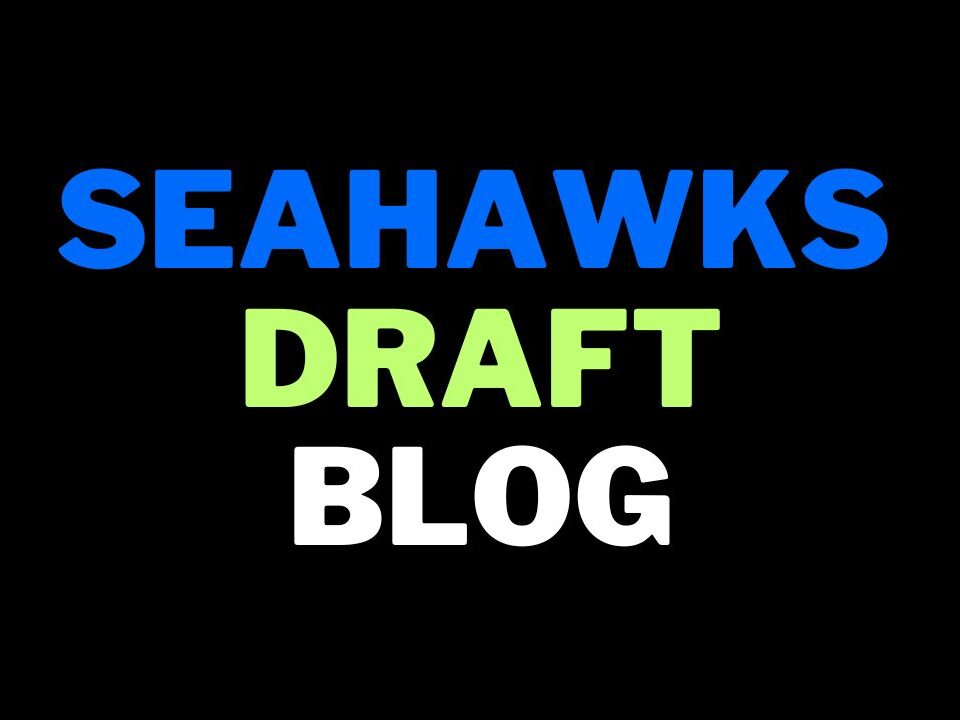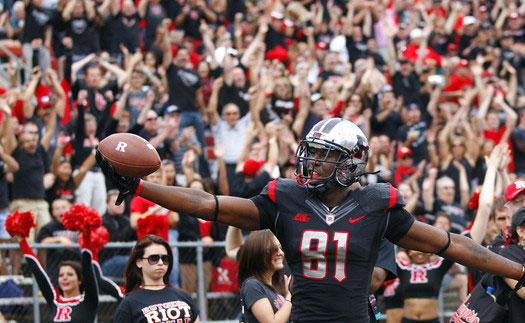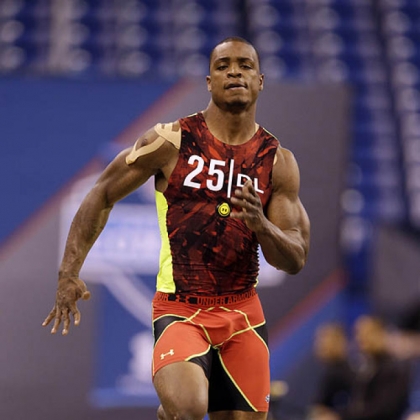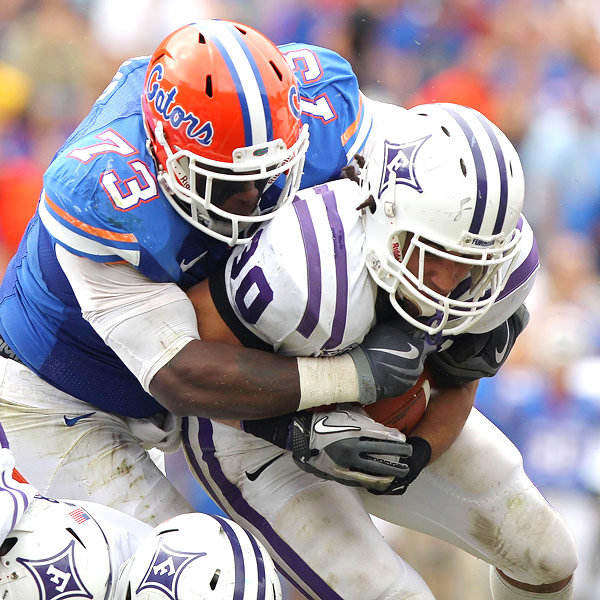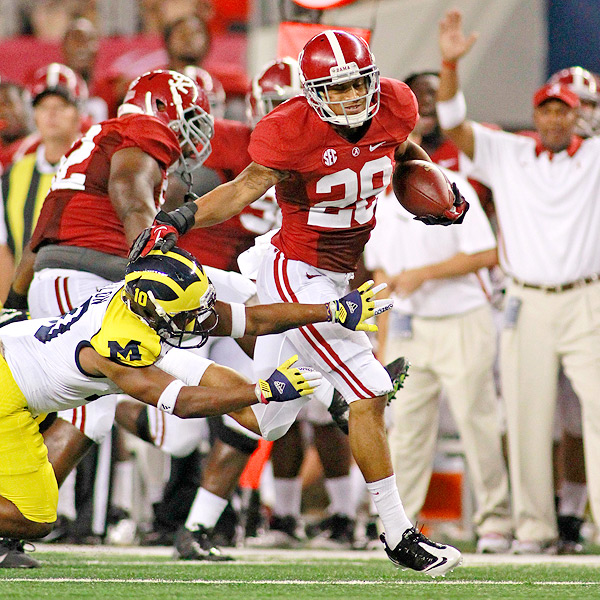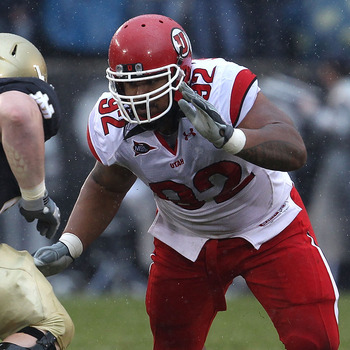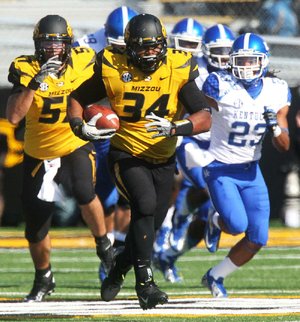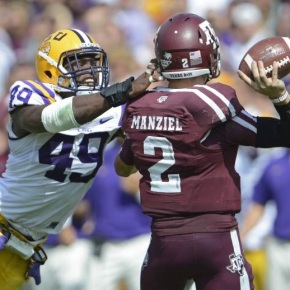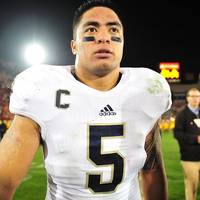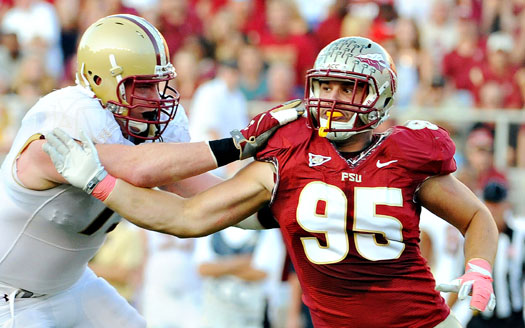
And he knows how to use them
Be sure to check out Rob’s article on Jarvis Jones if you missed it yesterday.
Last year, we predicted that Seattle would go pass rusher in round one. We predicted Seattle would go linebacker in round two. We predicted they’d go running back in round three and quarterback in round four. I also thought they’d add a second linebacker, as well as a corner and safety in the later picks.
Basically, we completely nailed it, other than Seattle flip-flopping rounds three and four. While it would be fun to brag, we had some help from some sources with close contacts to the front office, and that information proved extremely accurate, even if a few of the names we were given missed the mark. Rob even remembers being told that quarterback had possibly moved to a round three priority about a month before the draft, and if we had adjusted for that, we would have basically batted a thousand last year in regards to guessing the order in which needs were addressed. I remembered hearing that nugget about a quarterback, but for whatever reason I forgot to adjust my projection and was genuinely surprised (in an extremely good way) when Wilson was our 3rd round pick.
This year we’ve had less insider information to go with, which of course coincides with a draft that is widely considered one of the deepest and most unpredictable groups ever. We are cranking out two articles almost every day and I still think we’ll come up well short of naming every realistic option in the earliest rounds. Be ready for surprises.
During a recent press conference or interview, John Schneider talked about how there were nice “pockets” of talent here and there during this draft. We understand that running back was considered to be a round 1-3 priority last year since they liked the talent pool in that area. It ended up being pushed back one round, but they still got a very nice talent in Robert Turbin. They thought that pass rusher had to be a very high priority. They liked quarterback in rounds 4-6, although that was later bumped up to round three for a specific quarterback who’s stock was rising. I would guess that John Schneider probably had an undrafted free agent pocket for receivers, as he added three UDFA receivers that year and later talked about how he thought it was a weak receiver class. We saw a gap in this information and concluded that linebacker would be an early priority as well, probably the second round.
So what might those pockets look like this year? I have no scoop to give you this time, so with nothing other than a few clues and my trusty gut, here are what I think the 2013 draft pockets might look like for the Seahawks this year:
___________
Interior Pass Rush: Rounds 1-2.
LEO: Rounds 1-4.
Wide Receiver: Rounds 1-4.
Linebacker: Rounds 2-5.
Offensive Tackle: Rounds 3-5.
Corner: Rounds 4-7.
Tight end: Round 5-7.
Safety: Rounds 5-7.
___________
Defensive tackle:
Seattle wants to improve their pass rush, and it will be an early priority if the exasperation in Pete Carroll’s voice after the Falcon’s game is any indication. Good pass rushing defensive tackles are some of the rarest and most valuable players in the NFL. They are extremely hard to project during the draft process. I think that’s underscored by guys like Geno Atkins and Henry Melton, who are among the NFL’s best but were just 4th round picks. In a draft where defensive line talent is (in my opinion) being overshot in evaluations, finding that mid round steal will be pretty hard this year. If you even have the physical potential to be Melton or Atkins, you are going to leave the board very early this year. Probably as a result of Seattle’s success, teams are starting to weigh upside more heavily than risk this year.
Further, there just aren’t a ton of physically gifted defensive tackles this year. Only two defensive tackles posted forty times under five seconds. Jones’ time was easily the fastest this year, but it would not have been the fastest in any of the four previous drafts.* It’s hard to be a great pass rushing 3-tech if you don’t have speed, and there aren’t a ton of them with speed this year. If you want a fast defensive tackle, your options are basically between Datone Jones, Sheldon Richardson, and Sharrif Floyd. Floyd will be off the board in the top five. Richardson will probably leave the board in the top twenty. Jones will probably leave the board in the late teens to late twenties. If you want one of these potential difference makers, it’s starting to look like you’d need to take him in round one, if you were fortunate enough to get the chance.
*Interestingly, there are some really good defensive tackles just ahead of Datone (4.80) Jones in the speed rankings over the last 4 years: Henry Melton (4.65), Geno Atkins (4.75), Cameron Jordan (4.74 official), Fletcher Cox (4.77). So there is a pretty good correlation between speed and production. Fun fact: Jaye Howard (4.83), Clinton McDonald (4.83), and Jason Jones (4.76) all ran forties at or under 4.83. I think it’s safe to say this isn’t a coincidence. It appears Seattle is aware that speed kills at defensive tackle.
The Seahawks could wait for round two, but I don’t think they’d pass on Richardson or Datone Jones if they were available, not unless Werner or Jarvis Jones fell, and the reasons that caused that fall didn’t apply to the Seahawks. I am reasonably sure that Seattle would take Datone Jones over more “touted” outside rushers like Barkevious Mingo. Seattle can get a backup LEO later, but if they want a difference making interior pass rusher, it has to be very early.
In the event that none of those three defensive tackles make it, Seattle might possibly trade down or consider the best remaining option in round two if they don’t like Kawann Short enough to take him this early. Candidates in round two include Brandon Williams, Sylvester Williams, and (if I had my druthers) John Simon. I have a really hard time envisioning a draft where Seattle does not select a defensive tackle in the first two rounds, barring an unexpectedly fruitful free agency (such as signing Desmond Bryant while also retaining Jason Jones).
LEO:
Last year I watched Bruce Irvin with a focused eye every week, and when he was rarely put in true three down situations (i.e. not against a two-minute offense), the near automatic result was that Irvin vanished. Irvin is a special athlete who creates pressure mostly from a blistering edge rush, but since his repertoire is so limited he has to commit fully to that one tactic and to beat NFL tackles. With such a one dimensional attack Irvin has had no choice but to sell out as a pass rusher to achieve results.
Irvin has the speed to be a LEO, but not the technique, not the size, and maybe not the strength. Irvin showed some good strength in college as a bullrusher, but after last season that strength did not appear to translate in the NFL. Because Irvin is undersized and underpowered, he must sell out to stop the run. Part of what makes Chris Clemons so great is that he can seamlessly play both the run and the pass on every play, doing an outstanding job in both areas. Compare that to Irvin, who has to sell out as a pass rusher to get sacks, and has to sell out as a run stopper to not get killed as a run stopper. Bruce Irvin did look like an ideal LEO in college, but in 2012 he did not.
I’m not ruling out the possibility of Irvin developing. After all, Chris Clemons himself entered the NFL as a 236 pound linebacker, and had a reputation as a poor run defender for many years before arriving in Seattle. It took a long time, but he turned into a terrific all around defensive end. Irvin is much more gifted physically than Clemons, a 2003 UDFA, was. As one of Irvin’s very biggest fans before the 2012 draft, I won’t be the guy to put limits on his potential.
Regardless, that day when Irvin becomes a complete player is not assured, and if/when it does happen, it’s not likely to be in time for the 2013 opener. With Clemons turning 32 next season and coming off an ACL, Seattle can’t afford to risk being in position to force Irvin into a role he’s not ready for. When Pete talked about needing pass rushers in the plural, I’m sure it was for this exact reason. We need depth, and preferably an improved future at pass rushing end.
With the rest of the league playing copycat and looking for the next Bruce Irvin type, Seattle probably won’t be able to wait long if they want a quality option at LEO. If they rate Werner as being athletic enough, or if they rate Jarvis Jones as healthy enough, they might strongly consider either at #25 if a dramatic draft fall occurs for either one. Barkevious Mingo will probably not reach Seattle’s pick, but he could be considered as well.
I think a more likely scenario is that Seattle goes for a defensive tackle like Richardson, Jones, or Short in round one, and then hope to get Corey Lemonier in round two. If Lemonier is gone at #58, Seattle might consider a few other options in the rounds 2-4 range.
While Alex Okafor seems far too slow to be a classic LEO, he is a complete defensive end with good run defense, good size, and an excellent pass rush repertoire (as well as good college production). Given that even a young, 236 pound Clemons didn’t have blistering speed, I would guess that last year’s Chris Clemons probably wouldn’t beat Okafor in a footrace by much. So in a situation where the best fast options are all gone, Okafor could come into play if he’s there in round two. I would keep an eye on Armonty Bryant as a 3rd or 4th round option as well. Like Okafor, he doesn’t have LEO speed, but has other dominant traits that more than compensate. Brandon Jenkins opted not to run at the combine, and he looks like he’s a decent but not great 4.7 on tape (my estimate). He had a rough combine in drills, although I think his tape is pretty good- he’s definitely a natural LEO in terms of how he plays the position. Cornelius Carradine might be an option in this range as well.
If Seattle is adamant about drafting for speed at LEO, Margus Hunt, Ty Powell, Devin Taylor, Cornelius Washington and Trevardo Williams bring excellent athleticism but are completely undeveloped. And in the case of Williams, I think he’s probably a 4-3 linebacker anyway. Devin Taylor posted a so-so 4.72 forty time, but I’m intrigued with his 1.59 ten yard split and he had a very strong combine overall.
Wide Receiver:
Seattle needs depth at receiver and is hoping for an upgrade as well. Seattle likes fast receivers with quick feet that can gain yards after the catch. They will probably prefer a receiver with deep ball skills, so either one that is fast and tall or one that is fast and can jump high. I think they will rate Cordarrelle Patterson very highly, and if he’s there Seattle will have an interesting decision to make. Keenan Allen and Tavon Austin could be worth monitoring in round one as well. More likely, Seattle will keep tabs on options during the 2nd and 3rd rounds. In an extreme case, I could see Seattle waiting until the 4th round, as this receiver class is incredibly deep.
I expect Seattle will look to add a second receiver in the very late rounds or in UDFA. This group of receivers is too good to walk out with just one.
Linebacker:
It’s a very thin linebacker class this year, and Pete’s tone of contentment in a recent interview when discussing his “USC backup crew” (Malcolm Smith, Allen Bradford, Mike Morgan) makes me think he’s not too panicked about the position. Rather than talking about upgrading at weakside linebacker, Pete instead talked about finding “competition” for them. Basically, a peer among a group that includes just one player drafted as a linebacker: Malcolm Smith in the 7th round. Smith posted a 4.44 forty, Morgan a 4.46, and Bradford a 4.56. All would be among the very fastest among the linebackers this year. Practice squad player Korey Toomer clocked a 4.53 himself.
Alec Ogletree did not run the fastest forty, but is a gifted athlete. Arthur Brown drew rave reviews from Carroll coming out of high school, and is a sideline to sideline speedster. Khaseem Greene has average speed but has a great nose for the ball. You can see some players that might rate highly early, but I just think other needs will likely trump linebacker. I think it could be an emergency option in the event where the draft board at pass rusher and receiver do not fall kindly for Seattle, but my guess is that Seattle probably looks at linebacker in the middle rounds. Zaviar Gooden probably makes the most sense of all the fast linebackers available.
Offensive Tackle:
Seattle’s interest in Jordan Mills confirms that they are looking into offensive tackle. Mills is considered to be a mid-round prospect, although the report mentioned that Seattle might select Mills “earlier than you might think.” We’ll see. Unless Seattle absolutely loves freak athlete Menelik Watson, I can’t really see them drafting a tackle in round one or two.
Breno Giacomini was a penalty machine in the first half of last season, but down the stretch he seemed to get his act together. A polarizing player, Giacomini could be our worst lineman one week and our best lineman the next. I do not think Seattle is unhappy with Giacomini, but they might want to improve our depth situation at tackle. Frank Omiyale is a free agent, and Paul McQuistan is a free agent in 2014. Giacomini himself is in a contract year. So being proactive with the tackle situation in the 2013 draft makes sense.
Corner:
Seattle has drafted a corner every year since Pete took over, but never did they spend higher than a 4th round pick on one. In a year where as many as twenty corners are expected to go in the first 100 picks, we might see Seattle snag a corner a little earlier than we’re used to as a reaction to the behavior of the market. There are a very high number of fast corners with decent size this year.
Tight end:
Seattle got very good production out of Zach Miller and Anthony McCoy on a per-target basis last year. Miller may not be cheap, but he proved late in the season- especially in the postseason- how indispensable he is. While I really like Zach Ertz and think that Tyler Eifert is a perfect fit for Seattle, I just can’t see Seattle taking tight end in the early rounds with several other areas being much bigger areas for upgrade. I expect Seattle to look for a mid to late round value addition such as Travis Kelce or perhaps tweener Chris Gragg. The futures contract given to Darren Fells yesterday might also hint at the kind of investment at tight end Seattle is targeting for a 3rd option.
Safety:
The Winston Guy pick didn’t work out quite as hoped in 2012, and while I highly doubt they will give up on him just like that, Seattle could certainly look to add competition to the “big nickle” safety role currently held down by Jeron Johnson. Chris Maragos (a free agent) has provided the speedy safety depth needed for Earl Thomas the last couple years. Will Seattle bring Maragos back or seek an upgrade?
___________
Free agency could modify priorities, but I’m not really expecting that. Seattle wants to build through the draft. I think we’ll see a few complimentary signings. With Melton, Starks, and Johnson all being franchised, and talk that Cliff Avril will get megabucks, I don’t really see a likely scenario where the Seahawks draft plans change all that much based on free agency. That said, I’d love to see them be active at defensive tackle. I’d really hate to see us lose both Jones and Branch. Branch was a great contributor in 2011 and Jones was definitely helping before he got injured.
I don’t know if this is what John Schneider’s draft pockets actually look like, but hopefully I’m at least close. Last year was a lot of fun in large part because we felt prepared for what Seattle was going to do. It’s much more fun and interesting when the Seahawks draft players we actually know something about.
